Benefits of Agile Project Management Methodologies for IT Projects
VerifiedAdded on 2023/04/03
|17
|3495
|396
AI Summary
This article explores the benefits of using Agile project management methodologies for IT projects, focusing on handling change requirements, detecting faults, and increasing performance. It discusses popular types of Agile methodologies such as Extreme Programming, Scrum, Feature Driven Development, and Crystal Method. The article also includes a literature review on the effectiveness of Agile methodologies and concludes with the benefits of Agile for IT projects.
Contribute Materials
Your contribution can guide someone’s learning journey. Share your
documents today.

Running head: PROJECT MANAGEMENT METHODOLOGIES
Project Management Methodologies
Name of the Student
Name of the University
Author Note
Project Management Methodologies
Name of the Student
Name of the University
Author Note
Secure Best Marks with AI Grader
Need help grading? Try our AI Grader for instant feedback on your assignments.
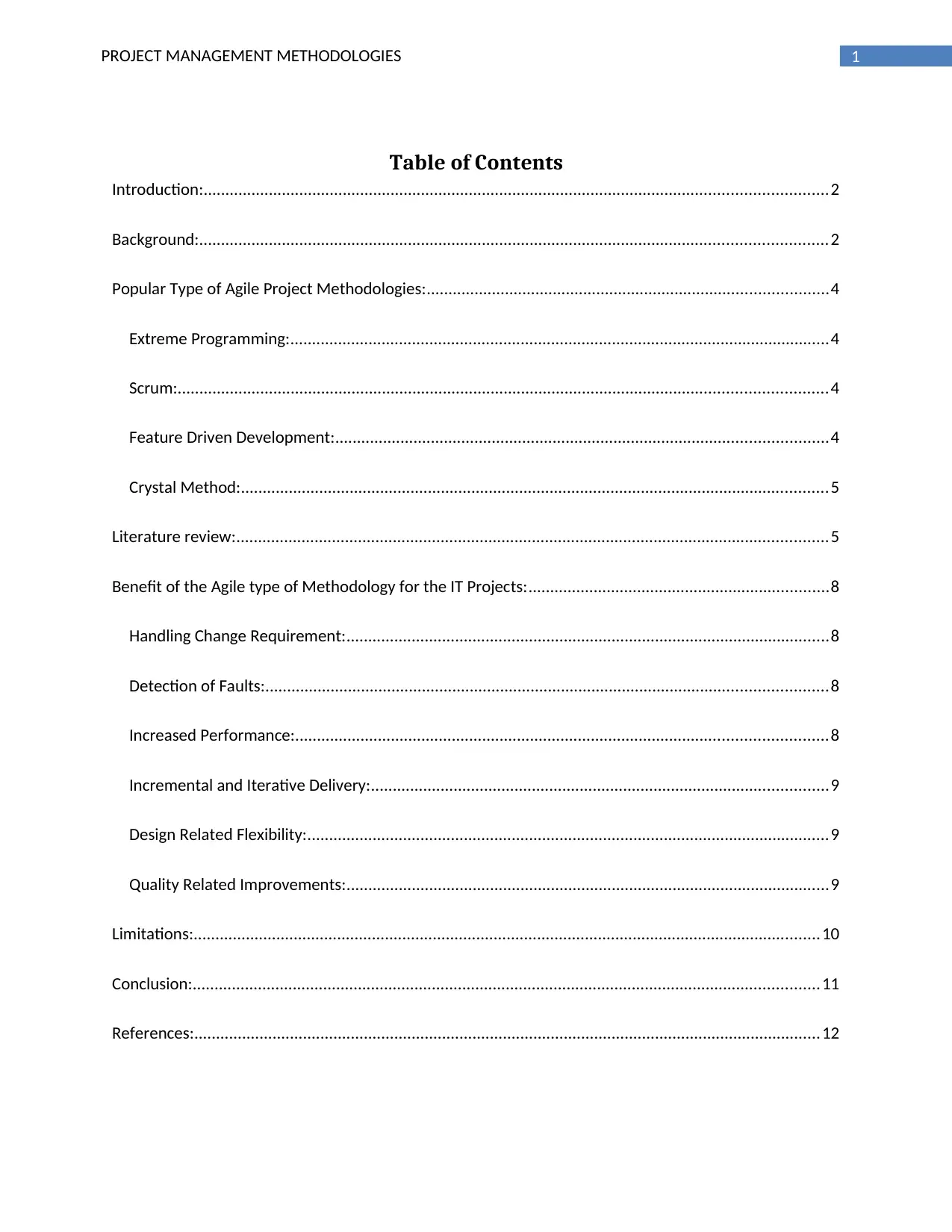
1PROJECT MANAGEMENT METHODOLOGIES
Table of Contents
Introduction:...............................................................................................................................................2
Background:................................................................................................................................................2
Popular Type of Agile Project Methodologies:............................................................................................4
Extreme Programming:............................................................................................................................4
Scrum:.....................................................................................................................................................4
Feature Driven Development:.................................................................................................................4
Crystal Method:.......................................................................................................................................5
Literature review:........................................................................................................................................5
Benefit of the Agile type of Methodology for the IT Projects:.....................................................................8
Handling Change Requirement:...............................................................................................................8
Detection of Faults:.................................................................................................................................8
Increased Performance:..........................................................................................................................8
Incremental and Iterative Delivery:.........................................................................................................9
Design Related Flexibility:........................................................................................................................9
Quality Related Improvements:...............................................................................................................9
Limitations:................................................................................................................................................10
Conclusion:................................................................................................................................................11
References:................................................................................................................................................12
Table of Contents
Introduction:...............................................................................................................................................2
Background:................................................................................................................................................2
Popular Type of Agile Project Methodologies:............................................................................................4
Extreme Programming:............................................................................................................................4
Scrum:.....................................................................................................................................................4
Feature Driven Development:.................................................................................................................4
Crystal Method:.......................................................................................................................................5
Literature review:........................................................................................................................................5
Benefit of the Agile type of Methodology for the IT Projects:.....................................................................8
Handling Change Requirement:...............................................................................................................8
Detection of Faults:.................................................................................................................................8
Increased Performance:..........................................................................................................................8
Incremental and Iterative Delivery:.........................................................................................................9
Design Related Flexibility:........................................................................................................................9
Quality Related Improvements:...............................................................................................................9
Limitations:................................................................................................................................................10
Conclusion:................................................................................................................................................11
References:................................................................................................................................................12

2PROJECT MANAGEMENT METHODOLOGIES
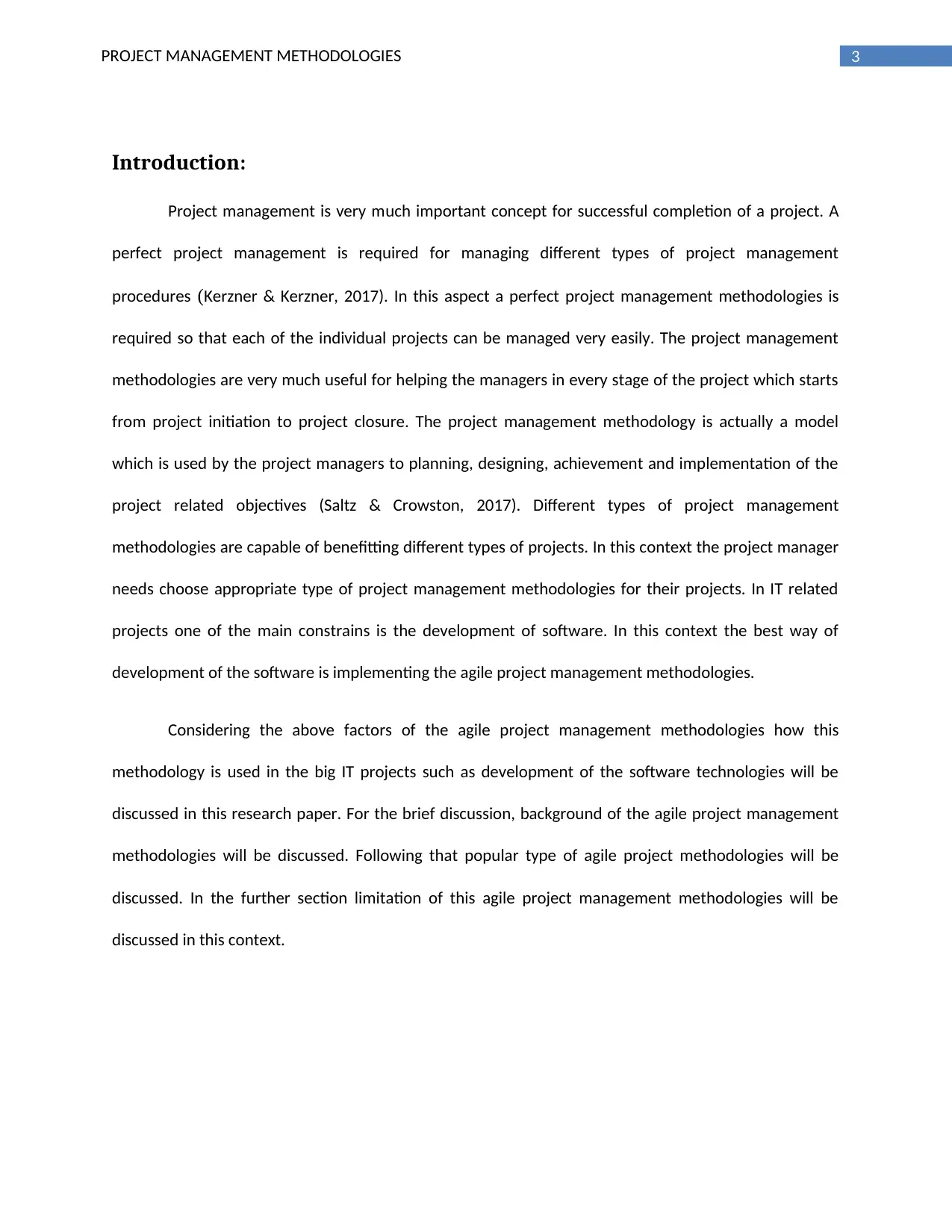
3PROJECT MANAGEMENT METHODOLOGIES
Introduction:
Project management is very much important concept for successful completion of a project. A
perfect project management is required for managing different types of project management
procedures (Kerzner & Kerzner, 2017). In this aspect a perfect project management methodologies is
required so that each of the individual projects can be managed very easily. The project management
methodologies are very much useful for helping the managers in every stage of the project which starts
from project initiation to project closure. The project management methodology is actually a model
which is used by the project managers to planning, designing, achievement and implementation of the
project related objectives (Saltz & Crowston, 2017). Different types of project management
methodologies are capable of benefitting different types of projects. In this context the project manager
needs choose appropriate type of project management methodologies for their projects. In IT related
projects one of the main constrains is the development of software. In this context the best way of
development of the software is implementing the agile project management methodologies.
Considering the above factors of the agile project management methodologies how this
methodology is used in the big IT projects such as development of the software technologies will be
discussed in this research paper. For the brief discussion, background of the agile project management
methodologies will be discussed. Following that popular type of agile project methodologies will be
discussed. In the further section limitation of this agile project management methodologies will be
discussed in this context.
Introduction:
Project management is very much important concept for successful completion of a project. A
perfect project management is required for managing different types of project management
procedures (Kerzner & Kerzner, 2017). In this aspect a perfect project management methodologies is
required so that each of the individual projects can be managed very easily. The project management
methodologies are very much useful for helping the managers in every stage of the project which starts
from project initiation to project closure. The project management methodology is actually a model
which is used by the project managers to planning, designing, achievement and implementation of the
project related objectives (Saltz & Crowston, 2017). Different types of project management
methodologies are capable of benefitting different types of projects. In this context the project manager
needs choose appropriate type of project management methodologies for their projects. In IT related
projects one of the main constrains is the development of software. In this context the best way of
development of the software is implementing the agile project management methodologies.
Considering the above factors of the agile project management methodologies how this
methodology is used in the big IT projects such as development of the software technologies will be
discussed in this research paper. For the brief discussion, background of the agile project management
methodologies will be discussed. Following that popular type of agile project methodologies will be
discussed. In the further section limitation of this agile project management methodologies will be
discussed in this context.
Secure Best Marks with AI Grader
Need help grading? Try our AI Grader for instant feedback on your assignments.
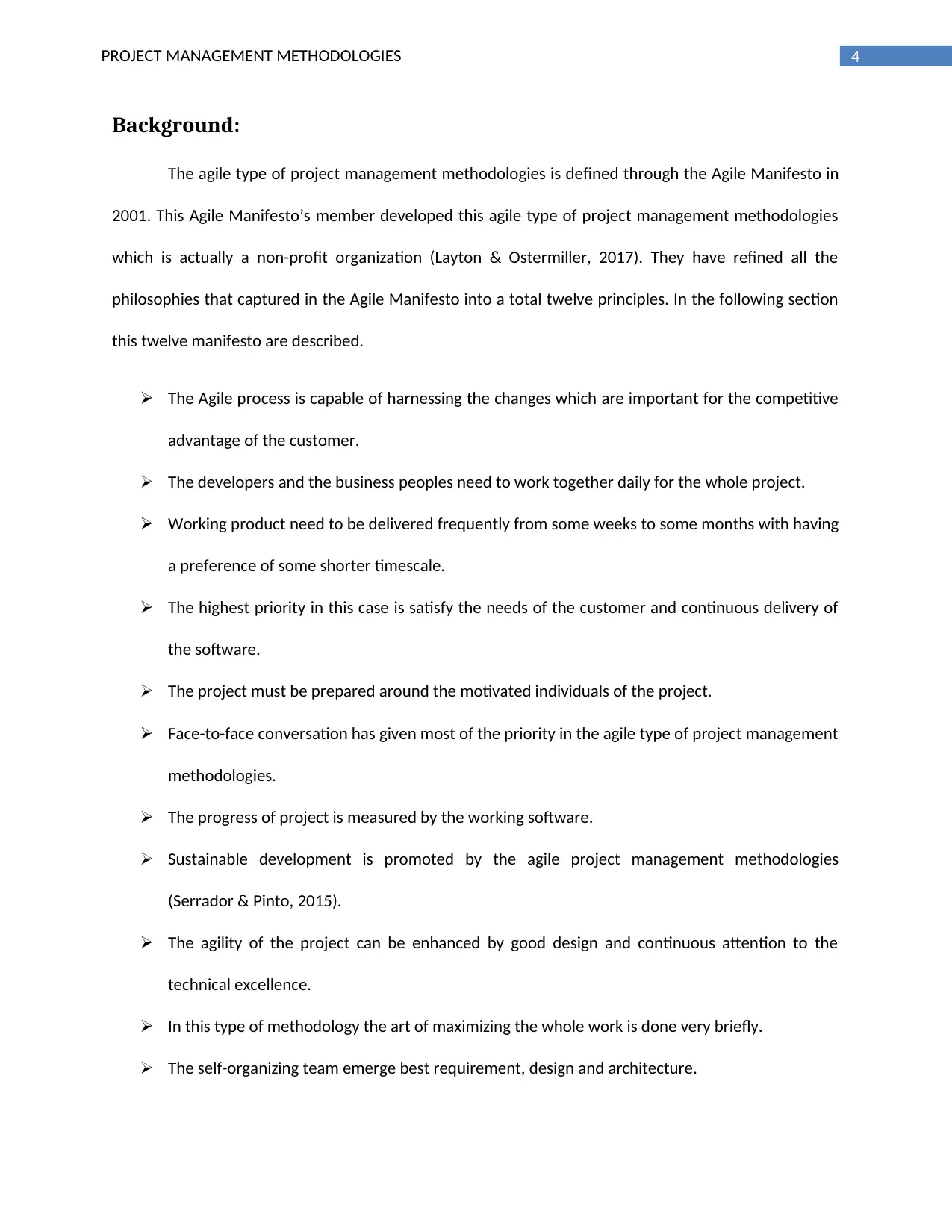
4PROJECT MANAGEMENT METHODOLOGIES
Background:
The agile type of project management methodologies is defined through the Agile Manifesto in
2001. This Agile Manifesto’s member developed this agile type of project management methodologies
which is actually a non-profit organization (Layton & Ostermiller, 2017). They have refined all the
philosophies that captured in the Agile Manifesto into a total twelve principles. In the following section
this twelve manifesto are described.
The Agile process is capable of harnessing the changes which are important for the competitive
advantage of the customer.
The developers and the business peoples need to work together daily for the whole project.
Working product need to be delivered frequently from some weeks to some months with having
a preference of some shorter timescale.
The highest priority in this case is satisfy the needs of the customer and continuous delivery of
the software.
The project must be prepared around the motivated individuals of the project.
Face-to-face conversation has given most of the priority in the agile type of project management
methodologies.
The progress of project is measured by the working software.
Sustainable development is promoted by the agile project management methodologies
(Serrador & Pinto, 2015).
The agility of the project can be enhanced by good design and continuous attention to the
technical excellence.
In this type of methodology the art of maximizing the whole work is done very briefly.
The self-organizing team emerge best requirement, design and architecture.
Background:
The agile type of project management methodologies is defined through the Agile Manifesto in
2001. This Agile Manifesto’s member developed this agile type of project management methodologies
which is actually a non-profit organization (Layton & Ostermiller, 2017). They have refined all the
philosophies that captured in the Agile Manifesto into a total twelve principles. In the following section
this twelve manifesto are described.
The Agile process is capable of harnessing the changes which are important for the competitive
advantage of the customer.
The developers and the business peoples need to work together daily for the whole project.
Working product need to be delivered frequently from some weeks to some months with having
a preference of some shorter timescale.
The highest priority in this case is satisfy the needs of the customer and continuous delivery of
the software.
The project must be prepared around the motivated individuals of the project.
Face-to-face conversation has given most of the priority in the agile type of project management
methodologies.
The progress of project is measured by the working software.
Sustainable development is promoted by the agile project management methodologies
(Serrador & Pinto, 2015).
The agility of the project can be enhanced by good design and continuous attention to the
technical excellence.
In this type of methodology the art of maximizing the whole work is done very briefly.
The self-organizing team emerge best requirement, design and architecture.
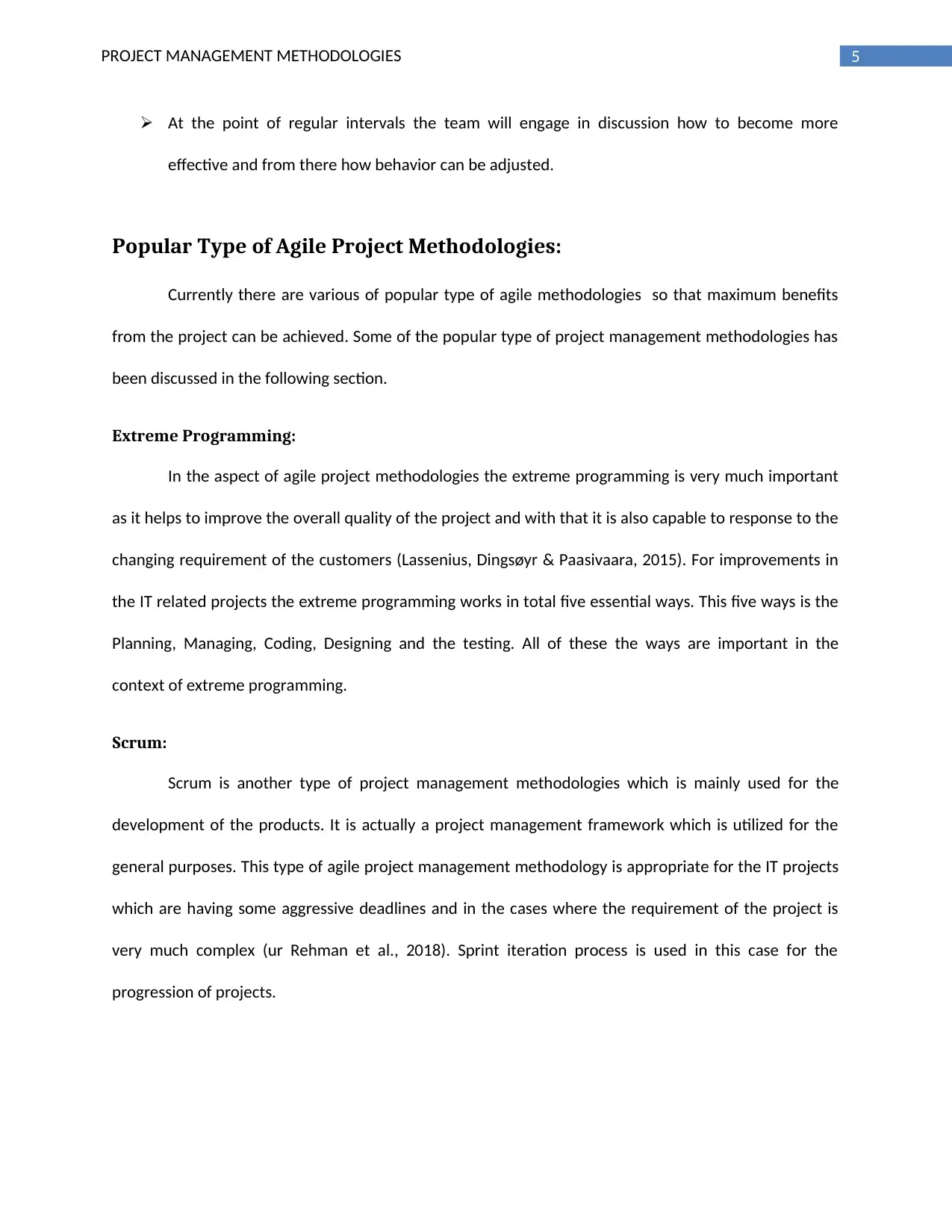
5PROJECT MANAGEMENT METHODOLOGIES
At the point of regular intervals the team will engage in discussion how to become more
effective and from there how behavior can be adjusted.
Popular Type of Agile Project Methodologies:
Currently there are various of popular type of agile methodologies so that maximum benefits
from the project can be achieved. Some of the popular type of project management methodologies has
been discussed in the following section.
Extreme Programming:
In the aspect of agile project methodologies the extreme programming is very much important
as it helps to improve the overall quality of the project and with that it is also capable to response to the
changing requirement of the customers (Lassenius, Dingsøyr & Paasivaara, 2015). For improvements in
the IT related projects the extreme programming works in total five essential ways. This five ways is the
Planning, Managing, Coding, Designing and the testing. All of these the ways are important in the
context of extreme programming.
Scrum:
Scrum is another type of project management methodologies which is mainly used for the
development of the products. It is actually a project management framework which is utilized for the
general purposes. This type of agile project management methodology is appropriate for the IT projects
which are having some aggressive deadlines and in the cases where the requirement of the project is
very much complex (ur Rehman et al., 2018). Sprint iteration process is used in this case for the
progression of projects.
At the point of regular intervals the team will engage in discussion how to become more
effective and from there how behavior can be adjusted.
Popular Type of Agile Project Methodologies:
Currently there are various of popular type of agile methodologies so that maximum benefits
from the project can be achieved. Some of the popular type of project management methodologies has
been discussed in the following section.
Extreme Programming:
In the aspect of agile project methodologies the extreme programming is very much important
as it helps to improve the overall quality of the project and with that it is also capable to response to the
changing requirement of the customers (Lassenius, Dingsøyr & Paasivaara, 2015). For improvements in
the IT related projects the extreme programming works in total five essential ways. This five ways is the
Planning, Managing, Coding, Designing and the testing. All of these the ways are important in the
context of extreme programming.
Scrum:
Scrum is another type of project management methodologies which is mainly used for the
development of the products. It is actually a project management framework which is utilized for the
general purposes. This type of agile project management methodology is appropriate for the IT projects
which are having some aggressive deadlines and in the cases where the requirement of the project is
very much complex (ur Rehman et al., 2018). Sprint iteration process is used in this case for the
progression of projects.
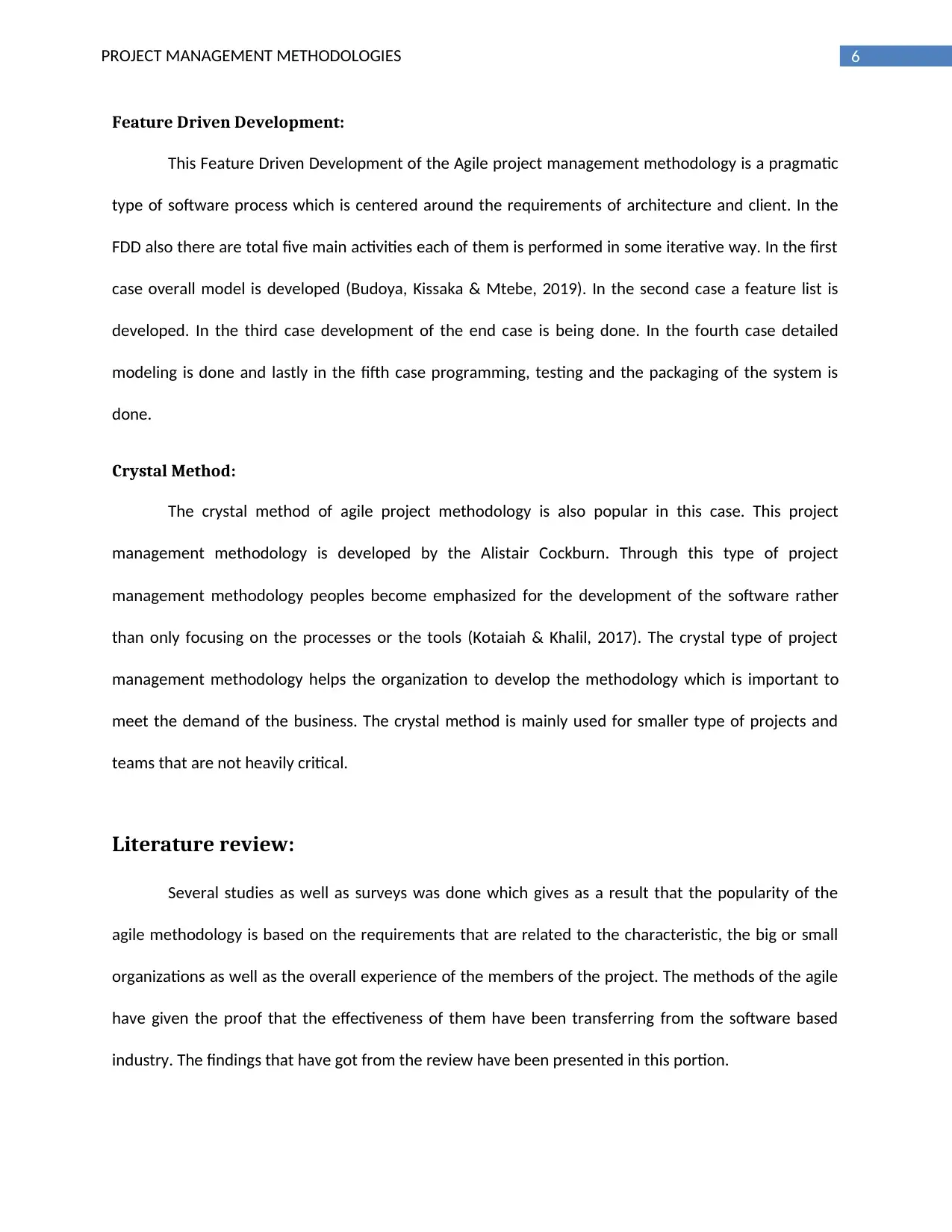
6PROJECT MANAGEMENT METHODOLOGIES
Feature Driven Development:
This Feature Driven Development of the Agile project management methodology is a pragmatic
type of software process which is centered around the requirements of architecture and client. In the
FDD also there are total five main activities each of them is performed in some iterative way. In the first
case overall model is developed (Budoya, Kissaka & Mtebe, 2019). In the second case a feature list is
developed. In the third case development of the end case is being done. In the fourth case detailed
modeling is done and lastly in the fifth case programming, testing and the packaging of the system is
done.
Crystal Method:
The crystal method of agile project methodology is also popular in this case. This project
management methodology is developed by the Alistair Cockburn. Through this type of project
management methodology peoples become emphasized for the development of the software rather
than only focusing on the processes or the tools (Kotaiah & Khalil, 2017). The crystal type of project
management methodology helps the organization to develop the methodology which is important to
meet the demand of the business. The crystal method is mainly used for smaller type of projects and
teams that are not heavily critical.
Literature review:
Several studies as well as surveys was done which gives as a result that the popularity of the
agile methodology is based on the requirements that are related to the characteristic, the big or small
organizations as well as the overall experience of the members of the project. The methods of the agile
have given the proof that the effectiveness of them have been transferring from the software based
industry. The findings that have got from the review have been presented in this portion.
Feature Driven Development:
This Feature Driven Development of the Agile project management methodology is a pragmatic
type of software process which is centered around the requirements of architecture and client. In the
FDD also there are total five main activities each of them is performed in some iterative way. In the first
case overall model is developed (Budoya, Kissaka & Mtebe, 2019). In the second case a feature list is
developed. In the third case development of the end case is being done. In the fourth case detailed
modeling is done and lastly in the fifth case programming, testing and the packaging of the system is
done.
Crystal Method:
The crystal method of agile project methodology is also popular in this case. This project
management methodology is developed by the Alistair Cockburn. Through this type of project
management methodology peoples become emphasized for the development of the software rather
than only focusing on the processes or the tools (Kotaiah & Khalil, 2017). The crystal type of project
management methodology helps the organization to develop the methodology which is important to
meet the demand of the business. The crystal method is mainly used for smaller type of projects and
teams that are not heavily critical.
Literature review:
Several studies as well as surveys was done which gives as a result that the popularity of the
agile methodology is based on the requirements that are related to the characteristic, the big or small
organizations as well as the overall experience of the members of the project. The methods of the agile
have given the proof that the effectiveness of them have been transferring from the software based
industry. The findings that have got from the review have been presented in this portion.
Paraphrase This Document
Need a fresh take? Get an instant paraphrase of this document with our AI Paraphraser
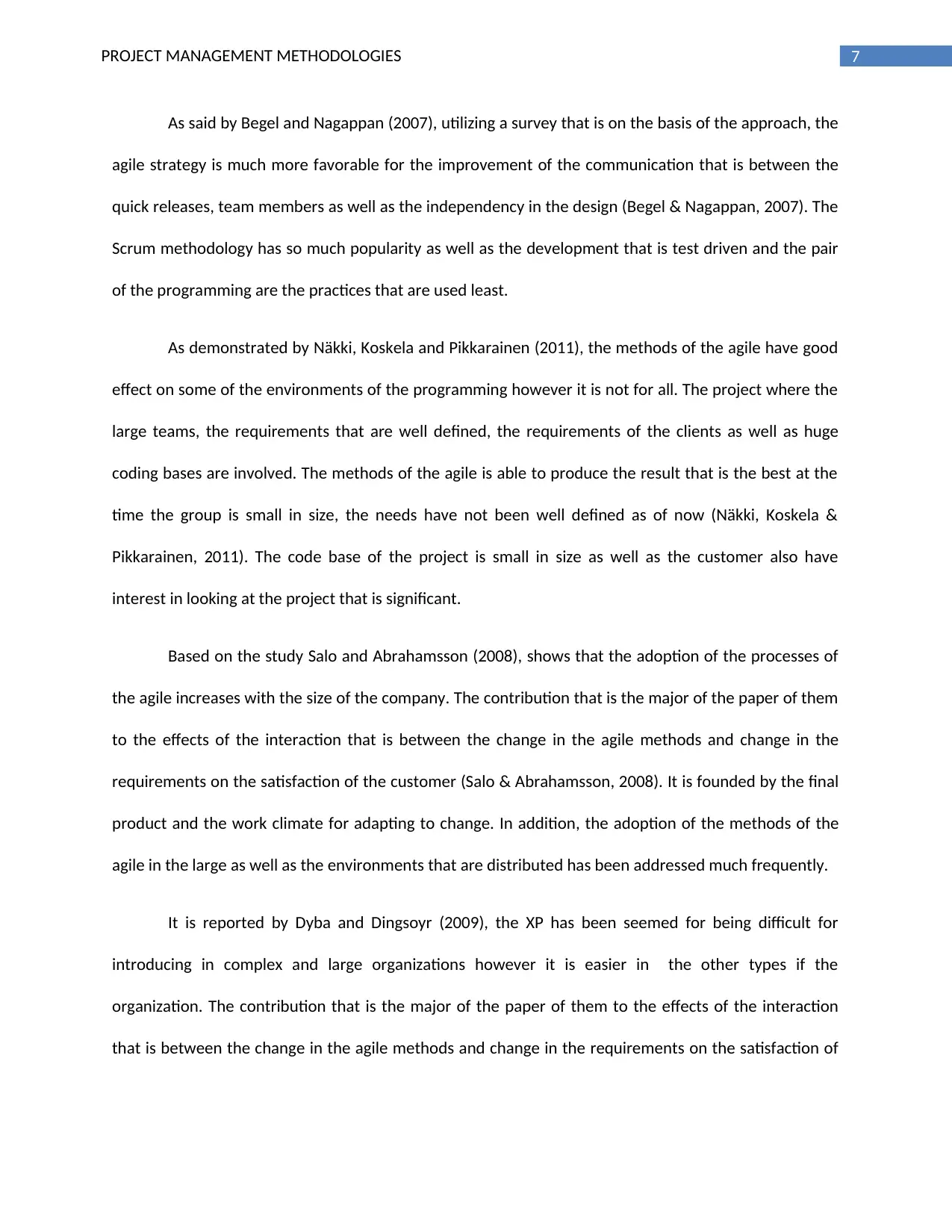
7PROJECT MANAGEMENT METHODOLOGIES
As said by Begel and Nagappan (2007), utilizing a survey that is on the basis of the approach, the
agile strategy is much more favorable for the improvement of the communication that is between the
quick releases, team members as well as the independency in the design (Begel & Nagappan, 2007). The
Scrum methodology has so much popularity as well as the development that is test driven and the pair
of the programming are the practices that are used least.
As demonstrated by Näkki, Koskela and Pikkarainen (2011), the methods of the agile have good
effect on some of the environments of the programming however it is not for all. The project where the
large teams, the requirements that are well defined, the requirements of the clients as well as huge
coding bases are involved. The methods of the agile is able to produce the result that is the best at the
time the group is small in size, the needs have not been well defined as of now (Näkki, Koskela &
Pikkarainen, 2011). The code base of the project is small in size as well as the customer also have
interest in looking at the project that is significant.
Based on the study Salo and Abrahamsson (2008), shows that the adoption of the processes of
the agile increases with the size of the company. The contribution that is the major of the paper of them
to the effects of the interaction that is between the change in the agile methods and change in the
requirements on the satisfaction of the customer (Salo & Abrahamsson, 2008). It is founded by the final
product and the work climate for adapting to change. In addition, the adoption of the methods of the
agile in the large as well as the environments that are distributed has been addressed much frequently.
It is reported by Dyba and Dingsoyr (2009), the XP has been seemed for being difficult for
introducing in complex and large organizations however it is easier in the other types if the
organization. The contribution that is the major of the paper of them to the effects of the interaction
that is between the change in the agile methods and change in the requirements on the satisfaction of
As said by Begel and Nagappan (2007), utilizing a survey that is on the basis of the approach, the
agile strategy is much more favorable for the improvement of the communication that is between the
quick releases, team members as well as the independency in the design (Begel & Nagappan, 2007). The
Scrum methodology has so much popularity as well as the development that is test driven and the pair
of the programming are the practices that are used least.
As demonstrated by Näkki, Koskela and Pikkarainen (2011), the methods of the agile have good
effect on some of the environments of the programming however it is not for all. The project where the
large teams, the requirements that are well defined, the requirements of the clients as well as huge
coding bases are involved. The methods of the agile is able to produce the result that is the best at the
time the group is small in size, the needs have not been well defined as of now (Näkki, Koskela &
Pikkarainen, 2011). The code base of the project is small in size as well as the customer also have
interest in looking at the project that is significant.
Based on the study Salo and Abrahamsson (2008), shows that the adoption of the processes of
the agile increases with the size of the company. The contribution that is the major of the paper of them
to the effects of the interaction that is between the change in the agile methods and change in the
requirements on the satisfaction of the customer (Salo & Abrahamsson, 2008). It is founded by the final
product and the work climate for adapting to change. In addition, the adoption of the methods of the
agile in the large as well as the environments that are distributed has been addressed much frequently.
It is reported by Dyba and Dingsoyr (2009), the XP has been seemed for being difficult for
introducing in complex and large organizations however it is easier in the other types if the
organization. The contribution that is the major of the paper of them to the effects of the interaction
that is between the change in the agile methods and change in the requirements on the satisfaction of
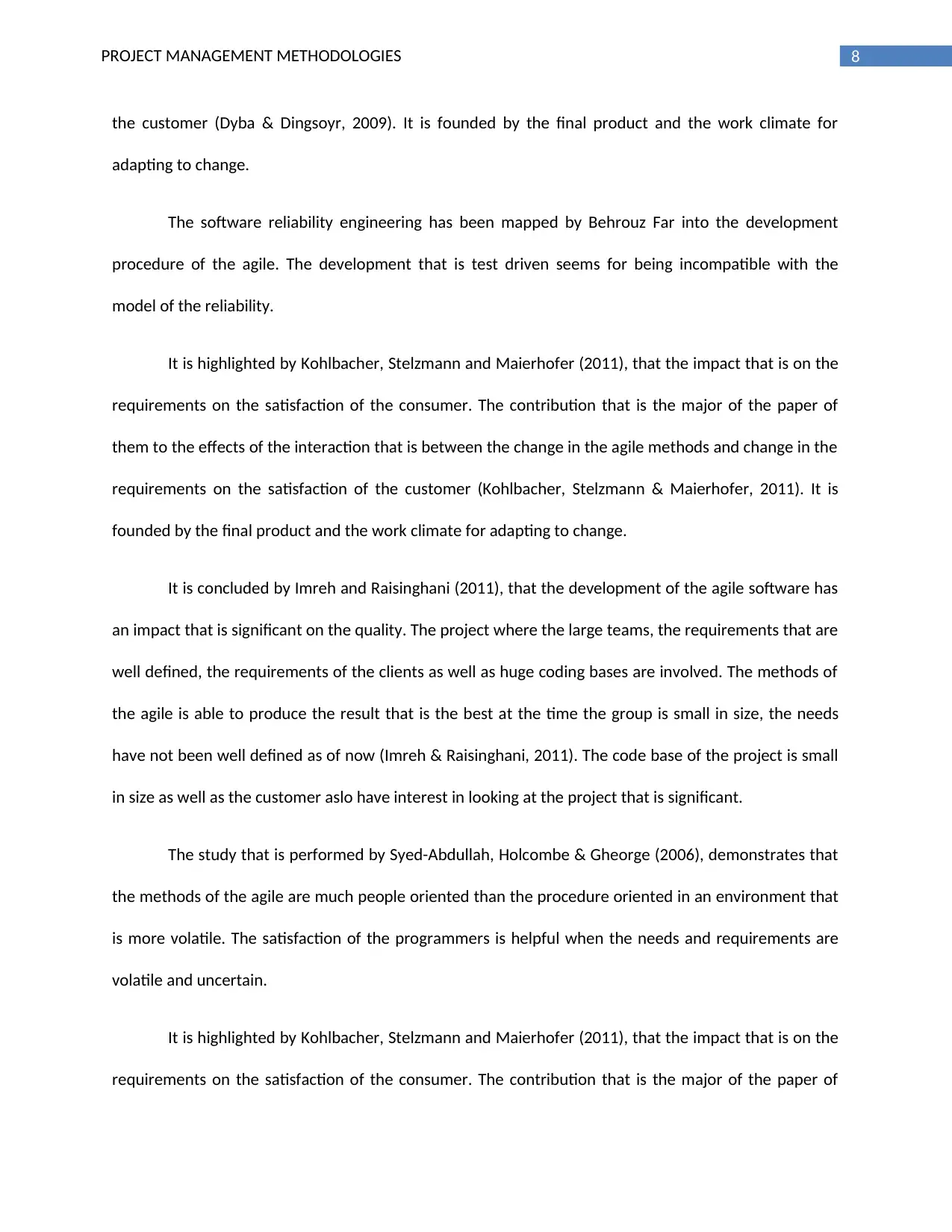
8PROJECT MANAGEMENT METHODOLOGIES
the customer (Dyba & Dingsoyr, 2009). It is founded by the final product and the work climate for
adapting to change.
The software reliability engineering has been mapped by Behrouz Far into the development
procedure of the agile. The development that is test driven seems for being incompatible with the
model of the reliability.
It is highlighted by Kohlbacher, Stelzmann and Maierhofer (2011), that the impact that is on the
requirements on the satisfaction of the consumer. The contribution that is the major of the paper of
them to the effects of the interaction that is between the change in the agile methods and change in the
requirements on the satisfaction of the customer (Kohlbacher, Stelzmann & Maierhofer, 2011). It is
founded by the final product and the work climate for adapting to change.
It is concluded by Imreh and Raisinghani (2011), that the development of the agile software has
an impact that is significant on the quality. The project where the large teams, the requirements that are
well defined, the requirements of the clients as well as huge coding bases are involved. The methods of
the agile is able to produce the result that is the best at the time the group is small in size, the needs
have not been well defined as of now (Imreh & Raisinghani, 2011). The code base of the project is small
in size as well as the customer aslo have interest in looking at the project that is significant.
The study that is performed by Syed-Abdullah, Holcombe & Gheorge (2006), demonstrates that
the methods of the agile are much people oriented than the procedure oriented in an environment that
is more volatile. The satisfaction of the programmers is helpful when the needs and requirements are
volatile and uncertain.
It is highlighted by Kohlbacher, Stelzmann and Maierhofer (2011), that the impact that is on the
requirements on the satisfaction of the consumer. The contribution that is the major of the paper of
the customer (Dyba & Dingsoyr, 2009). It is founded by the final product and the work climate for
adapting to change.
The software reliability engineering has been mapped by Behrouz Far into the development
procedure of the agile. The development that is test driven seems for being incompatible with the
model of the reliability.
It is highlighted by Kohlbacher, Stelzmann and Maierhofer (2011), that the impact that is on the
requirements on the satisfaction of the consumer. The contribution that is the major of the paper of
them to the effects of the interaction that is between the change in the agile methods and change in the
requirements on the satisfaction of the customer (Kohlbacher, Stelzmann & Maierhofer, 2011). It is
founded by the final product and the work climate for adapting to change.
It is concluded by Imreh and Raisinghani (2011), that the development of the agile software has
an impact that is significant on the quality. The project where the large teams, the requirements that are
well defined, the requirements of the clients as well as huge coding bases are involved. The methods of
the agile is able to produce the result that is the best at the time the group is small in size, the needs
have not been well defined as of now (Imreh & Raisinghani, 2011). The code base of the project is small
in size as well as the customer aslo have interest in looking at the project that is significant.
The study that is performed by Syed-Abdullah, Holcombe & Gheorge (2006), demonstrates that
the methods of the agile are much people oriented than the procedure oriented in an environment that
is more volatile. The satisfaction of the programmers is helpful when the needs and requirements are
volatile and uncertain.
It is highlighted by Kohlbacher, Stelzmann and Maierhofer (2011), that the impact that is on the
requirements on the satisfaction of the consumer. The contribution that is the major of the paper of
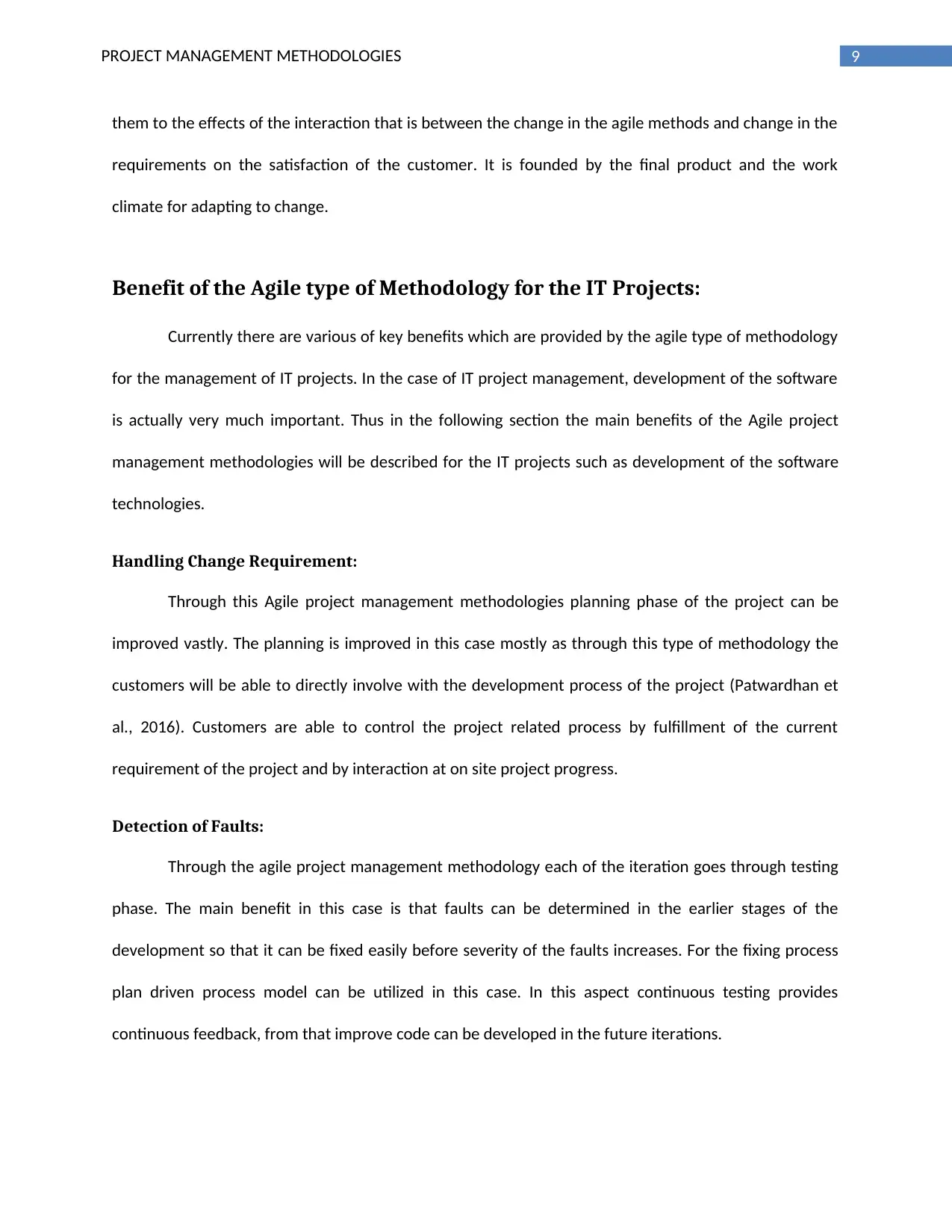
9PROJECT MANAGEMENT METHODOLOGIES
them to the effects of the interaction that is between the change in the agile methods and change in the
requirements on the satisfaction of the customer. It is founded by the final product and the work
climate for adapting to change.
Benefit of the Agile type of Methodology for the IT Projects:
Currently there are various of key benefits which are provided by the agile type of methodology
for the management of IT projects. In the case of IT project management, development of the software
is actually very much important. Thus in the following section the main benefits of the Agile project
management methodologies will be described for the IT projects such as development of the software
technologies.
Handling Change Requirement:
Through this Agile project management methodologies planning phase of the project can be
improved vastly. The planning is improved in this case mostly as through this type of methodology the
customers will be able to directly involve with the development process of the project (Patwardhan et
al., 2016). Customers are able to control the project related process by fulfillment of the current
requirement of the project and by interaction at on site project progress.
Detection of Faults:
Through the agile project management methodology each of the iteration goes through testing
phase. The main benefit in this case is that faults can be determined in the earlier stages of the
development so that it can be fixed easily before severity of the faults increases. For the fixing process
plan driven process model can be utilized in this case. In this aspect continuous testing provides
continuous feedback, from that improve code can be developed in the future iterations.
them to the effects of the interaction that is between the change in the agile methods and change in the
requirements on the satisfaction of the customer. It is founded by the final product and the work
climate for adapting to change.
Benefit of the Agile type of Methodology for the IT Projects:
Currently there are various of key benefits which are provided by the agile type of methodology
for the management of IT projects. In the case of IT project management, development of the software
is actually very much important. Thus in the following section the main benefits of the Agile project
management methodologies will be described for the IT projects such as development of the software
technologies.
Handling Change Requirement:
Through this Agile project management methodologies planning phase of the project can be
improved vastly. The planning is improved in this case mostly as through this type of methodology the
customers will be able to directly involve with the development process of the project (Patwardhan et
al., 2016). Customers are able to control the project related process by fulfillment of the current
requirement of the project and by interaction at on site project progress.
Detection of Faults:
Through the agile project management methodology each of the iteration goes through testing
phase. The main benefit in this case is that faults can be determined in the earlier stages of the
development so that it can be fixed easily before severity of the faults increases. For the fixing process
plan driven process model can be utilized in this case. In this aspect continuous testing provides
continuous feedback, from that improve code can be developed in the future iterations.
Secure Best Marks with AI Grader
Need help grading? Try our AI Grader for instant feedback on your assignments.
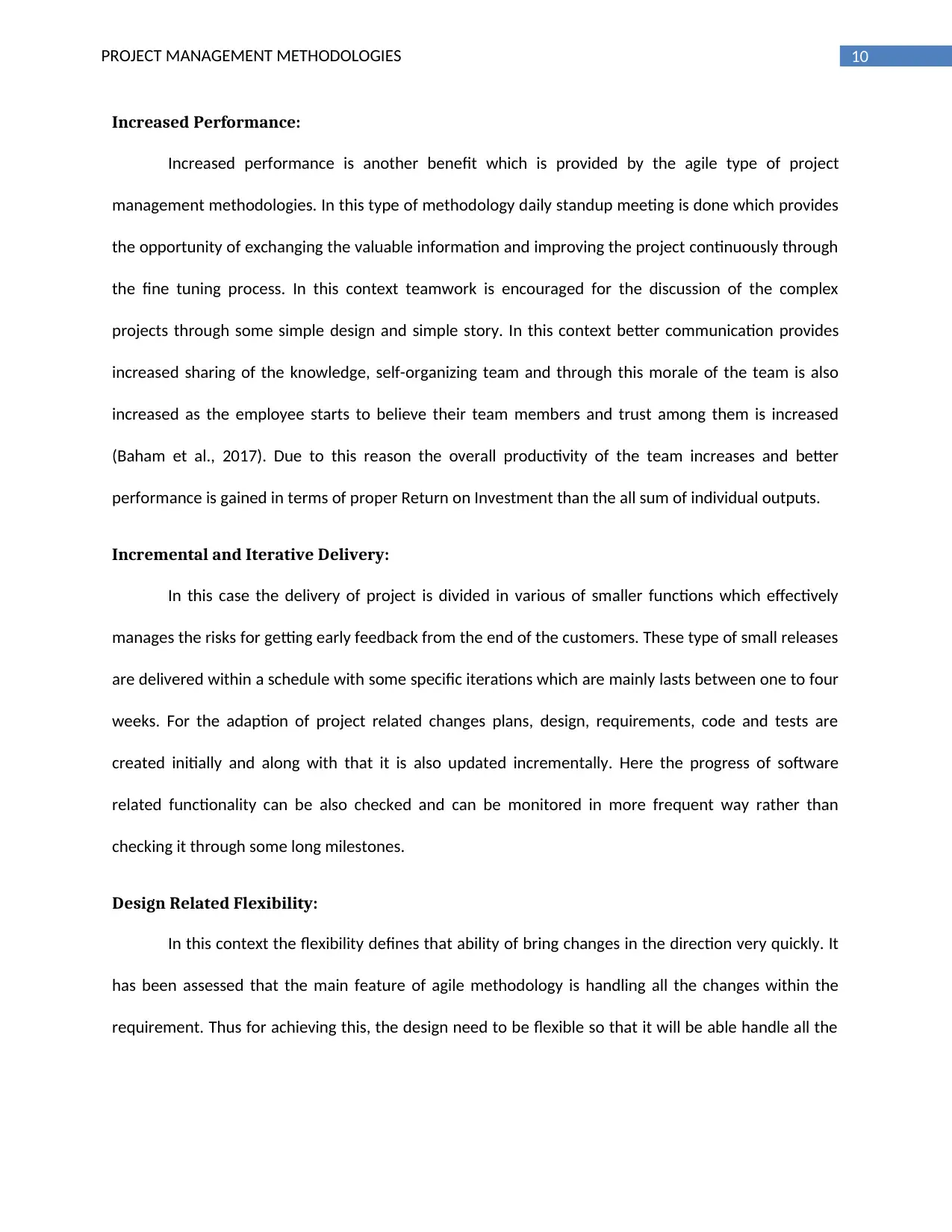
10PROJECT MANAGEMENT METHODOLOGIES
Increased Performance:
Increased performance is another benefit which is provided by the agile type of project
management methodologies. In this type of methodology daily standup meeting is done which provides
the opportunity of exchanging the valuable information and improving the project continuously through
the fine tuning process. In this context teamwork is encouraged for the discussion of the complex
projects through some simple design and simple story. In this context better communication provides
increased sharing of the knowledge, self-organizing team and through this morale of the team is also
increased as the employee starts to believe their team members and trust among them is increased
(Baham et al., 2017). Due to this reason the overall productivity of the team increases and better
performance is gained in terms of proper Return on Investment than the all sum of individual outputs.
Incremental and Iterative Delivery:
In this case the delivery of project is divided in various of smaller functions which effectively
manages the risks for getting early feedback from the end of the customers. These type of small releases
are delivered within a schedule with some specific iterations which are mainly lasts between one to four
weeks. For the adaption of project related changes plans, design, requirements, code and tests are
created initially and along with that it is also updated incrementally. Here the progress of software
related functionality can be also checked and can be monitored in more frequent way rather than
checking it through some long milestones.
Design Related Flexibility:
In this context the flexibility defines that ability of bring changes in the direction very quickly. It
has been assessed that the main feature of agile methodology is handling all the changes within the
requirement. Thus for achieving this, the design need to be flexible so that it will be able handle all the
Increased Performance:
Increased performance is another benefit which is provided by the agile type of project
management methodologies. In this type of methodology daily standup meeting is done which provides
the opportunity of exchanging the valuable information and improving the project continuously through
the fine tuning process. In this context teamwork is encouraged for the discussion of the complex
projects through some simple design and simple story. In this context better communication provides
increased sharing of the knowledge, self-organizing team and through this morale of the team is also
increased as the employee starts to believe their team members and trust among them is increased
(Baham et al., 2017). Due to this reason the overall productivity of the team increases and better
performance is gained in terms of proper Return on Investment than the all sum of individual outputs.
Incremental and Iterative Delivery:
In this case the delivery of project is divided in various of smaller functions which effectively
manages the risks for getting early feedback from the end of the customers. These type of small releases
are delivered within a schedule with some specific iterations which are mainly lasts between one to four
weeks. For the adaption of project related changes plans, design, requirements, code and tests are
created initially and along with that it is also updated incrementally. Here the progress of software
related functionality can be also checked and can be monitored in more frequent way rather than
checking it through some long milestones.
Design Related Flexibility:
In this context the flexibility defines that ability of bring changes in the direction very quickly. It
has been assessed that the main feature of agile methodology is handling all the changes within the
requirement. Thus for achieving this, the design need to be flexible so that it will be able handle all the
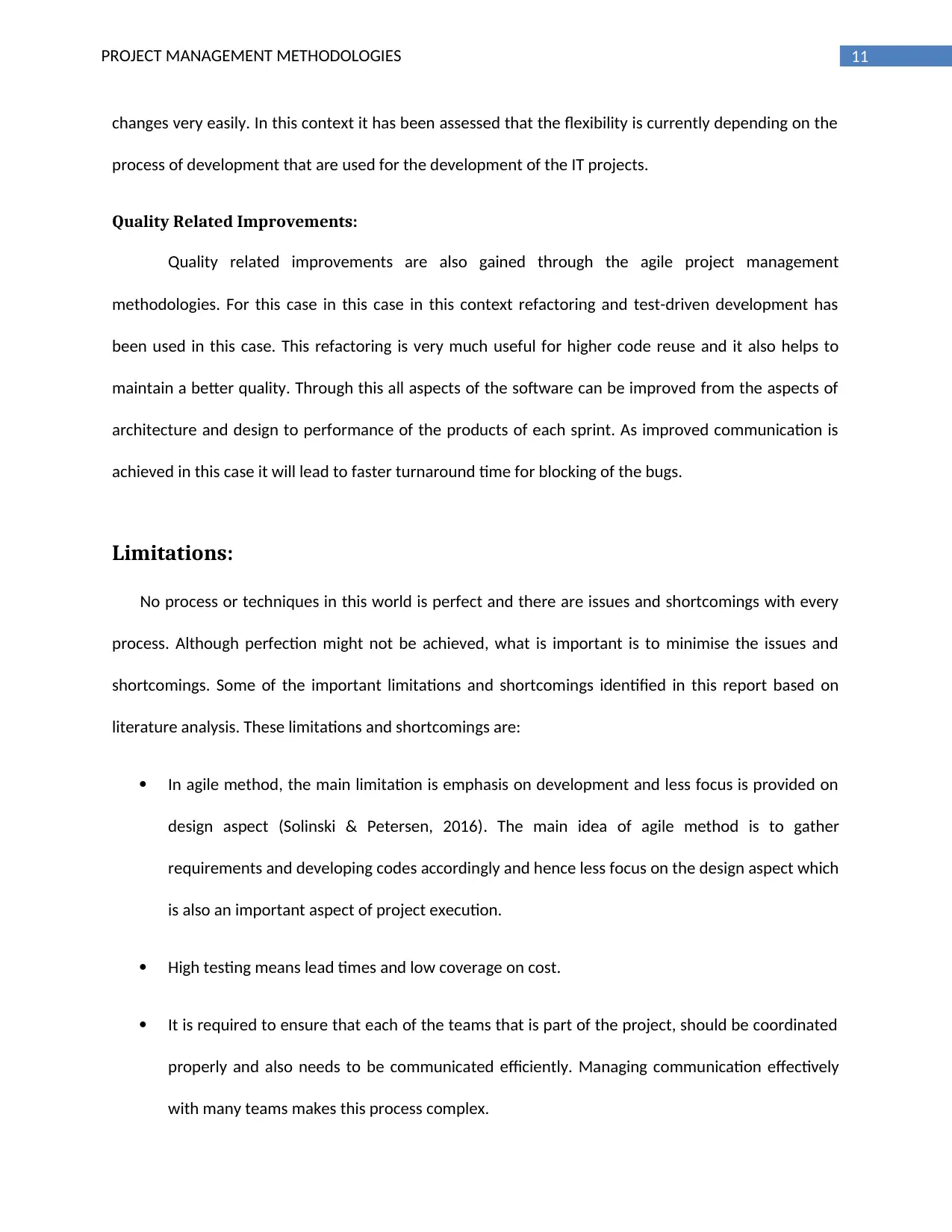
11PROJECT MANAGEMENT METHODOLOGIES
changes very easily. In this context it has been assessed that the flexibility is currently depending on the
process of development that are used for the development of the IT projects.
Quality Related Improvements:
Quality related improvements are also gained through the agile project management
methodologies. For this case in this case in this context refactoring and test-driven development has
been used in this case. This refactoring is very much useful for higher code reuse and it also helps to
maintain a better quality. Through this all aspects of the software can be improved from the aspects of
architecture and design to performance of the products of each sprint. As improved communication is
achieved in this case it will lead to faster turnaround time for blocking of the bugs.
Limitations:
No process or techniques in this world is perfect and there are issues and shortcomings with every
process. Although perfection might not be achieved, what is important is to minimise the issues and
shortcomings. Some of the important limitations and shortcomings identified in this report based on
literature analysis. These limitations and shortcomings are:
In agile method, the main limitation is emphasis on development and less focus is provided on
design aspect (Solinski & Petersen, 2016). The main idea of agile method is to gather
requirements and developing codes accordingly and hence less focus on the design aspect which
is also an important aspect of project execution.
High testing means lead times and low coverage on cost.
It is required to ensure that each of the teams that is part of the project, should be coordinated
properly and also needs to be communicated efficiently. Managing communication effectively
with many teams makes this process complex.
changes very easily. In this context it has been assessed that the flexibility is currently depending on the
process of development that are used for the development of the IT projects.
Quality Related Improvements:
Quality related improvements are also gained through the agile project management
methodologies. For this case in this case in this context refactoring and test-driven development has
been used in this case. This refactoring is very much useful for higher code reuse and it also helps to
maintain a better quality. Through this all aspects of the software can be improved from the aspects of
architecture and design to performance of the products of each sprint. As improved communication is
achieved in this case it will lead to faster turnaround time for blocking of the bugs.
Limitations:
No process or techniques in this world is perfect and there are issues and shortcomings with every
process. Although perfection might not be achieved, what is important is to minimise the issues and
shortcomings. Some of the important limitations and shortcomings identified in this report based on
literature analysis. These limitations and shortcomings are:
In agile method, the main limitation is emphasis on development and less focus is provided on
design aspect (Solinski & Petersen, 2016). The main idea of agile method is to gather
requirements and developing codes accordingly and hence less focus on the design aspect which
is also an important aspect of project execution.
High testing means lead times and low coverage on cost.
It is required to ensure that each of the teams that is part of the project, should be coordinated
properly and also needs to be communicated efficiently. Managing communication effectively
with many teams makes this process complex.
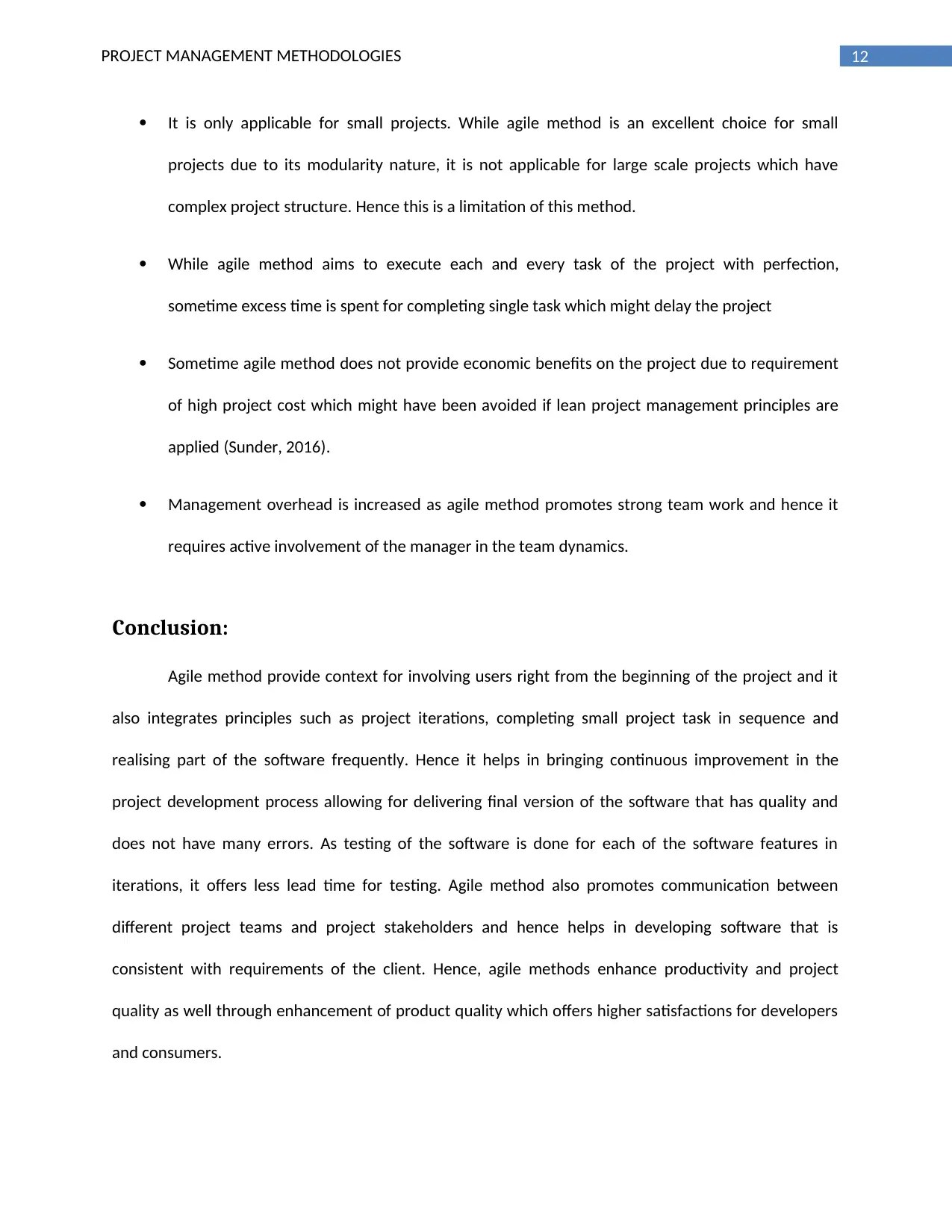
12PROJECT MANAGEMENT METHODOLOGIES
It is only applicable for small projects. While agile method is an excellent choice for small
projects due to its modularity nature, it is not applicable for large scale projects which have
complex project structure. Hence this is a limitation of this method.
While agile method aims to execute each and every task of the project with perfection,
sometime excess time is spent for completing single task which might delay the project
Sometime agile method does not provide economic benefits on the project due to requirement
of high project cost which might have been avoided if lean project management principles are
applied (Sunder, 2016).
Management overhead is increased as agile method promotes strong team work and hence it
requires active involvement of the manager in the team dynamics.
Conclusion:
Agile method provide context for involving users right from the beginning of the project and it
also integrates principles such as project iterations, completing small project task in sequence and
realising part of the software frequently. Hence it helps in bringing continuous improvement in the
project development process allowing for delivering final version of the software that has quality and
does not have many errors. As testing of the software is done for each of the software features in
iterations, it offers less lead time for testing. Agile method also promotes communication between
different project teams and project stakeholders and hence helps in developing software that is
consistent with requirements of the client. Hence, agile methods enhance productivity and project
quality as well through enhancement of product quality which offers higher satisfactions for developers
and consumers.
It is only applicable for small projects. While agile method is an excellent choice for small
projects due to its modularity nature, it is not applicable for large scale projects which have
complex project structure. Hence this is a limitation of this method.
While agile method aims to execute each and every task of the project with perfection,
sometime excess time is spent for completing single task which might delay the project
Sometime agile method does not provide economic benefits on the project due to requirement
of high project cost which might have been avoided if lean project management principles are
applied (Sunder, 2016).
Management overhead is increased as agile method promotes strong team work and hence it
requires active involvement of the manager in the team dynamics.
Conclusion:
Agile method provide context for involving users right from the beginning of the project and it
also integrates principles such as project iterations, completing small project task in sequence and
realising part of the software frequently. Hence it helps in bringing continuous improvement in the
project development process allowing for delivering final version of the software that has quality and
does not have many errors. As testing of the software is done for each of the software features in
iterations, it offers less lead time for testing. Agile method also promotes communication between
different project teams and project stakeholders and hence helps in developing software that is
consistent with requirements of the client. Hence, agile methods enhance productivity and project
quality as well through enhancement of product quality which offers higher satisfactions for developers
and consumers.
Paraphrase This Document
Need a fresh take? Get an instant paraphrase of this document with our AI Paraphraser

13PROJECT MANAGEMENT METHODOLOGIES
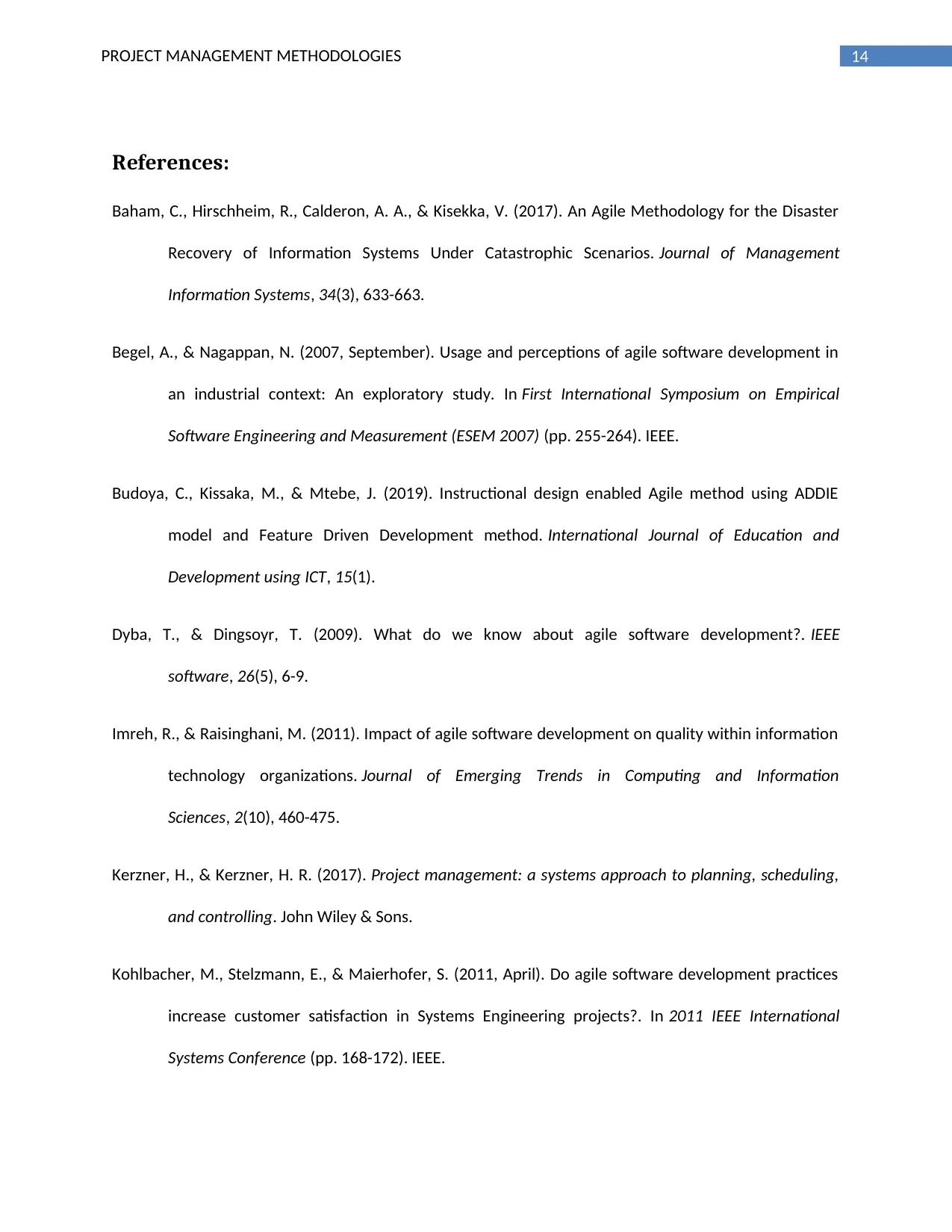
14PROJECT MANAGEMENT METHODOLOGIES
References:
Baham, C., Hirschheim, R., Calderon, A. A., & Kisekka, V. (2017). An Agile Methodology for the Disaster
Recovery of Information Systems Under Catastrophic Scenarios. Journal of Management
Information Systems, 34(3), 633-663.
Begel, A., & Nagappan, N. (2007, September). Usage and perceptions of agile software development in
an industrial context: An exploratory study. In First International Symposium on Empirical
Software Engineering and Measurement (ESEM 2007) (pp. 255-264). IEEE.
Budoya, C., Kissaka, M., & Mtebe, J. (2019). Instructional design enabled Agile method using ADDIE
model and Feature Driven Development method. International Journal of Education and
Development using ICT, 15(1).
Dyba, T., & Dingsoyr, T. (2009). What do we know about agile software development?. IEEE
software, 26(5), 6-9.
Imreh, R., & Raisinghani, M. (2011). Impact of agile software development on quality within information
technology organizations. Journal of Emerging Trends in Computing and Information
Sciences, 2(10), 460-475.
Kerzner, H., & Kerzner, H. R. (2017). Project management: a systems approach to planning, scheduling,
and controlling. John Wiley & Sons.
Kohlbacher, M., Stelzmann, E., & Maierhofer, S. (2011, April). Do agile software development practices
increase customer satisfaction in Systems Engineering projects?. In 2011 IEEE International
Systems Conference (pp. 168-172). IEEE.
References:
Baham, C., Hirschheim, R., Calderon, A. A., & Kisekka, V. (2017). An Agile Methodology for the Disaster
Recovery of Information Systems Under Catastrophic Scenarios. Journal of Management
Information Systems, 34(3), 633-663.
Begel, A., & Nagappan, N. (2007, September). Usage and perceptions of agile software development in
an industrial context: An exploratory study. In First International Symposium on Empirical
Software Engineering and Measurement (ESEM 2007) (pp. 255-264). IEEE.
Budoya, C., Kissaka, M., & Mtebe, J. (2019). Instructional design enabled Agile method using ADDIE
model and Feature Driven Development method. International Journal of Education and
Development using ICT, 15(1).
Dyba, T., & Dingsoyr, T. (2009). What do we know about agile software development?. IEEE
software, 26(5), 6-9.
Imreh, R., & Raisinghani, M. (2011). Impact of agile software development on quality within information
technology organizations. Journal of Emerging Trends in Computing and Information
Sciences, 2(10), 460-475.
Kerzner, H., & Kerzner, H. R. (2017). Project management: a systems approach to planning, scheduling,
and controlling. John Wiley & Sons.
Kohlbacher, M., Stelzmann, E., & Maierhofer, S. (2011, April). Do agile software development practices
increase customer satisfaction in Systems Engineering projects?. In 2011 IEEE International
Systems Conference (pp. 168-172). IEEE.
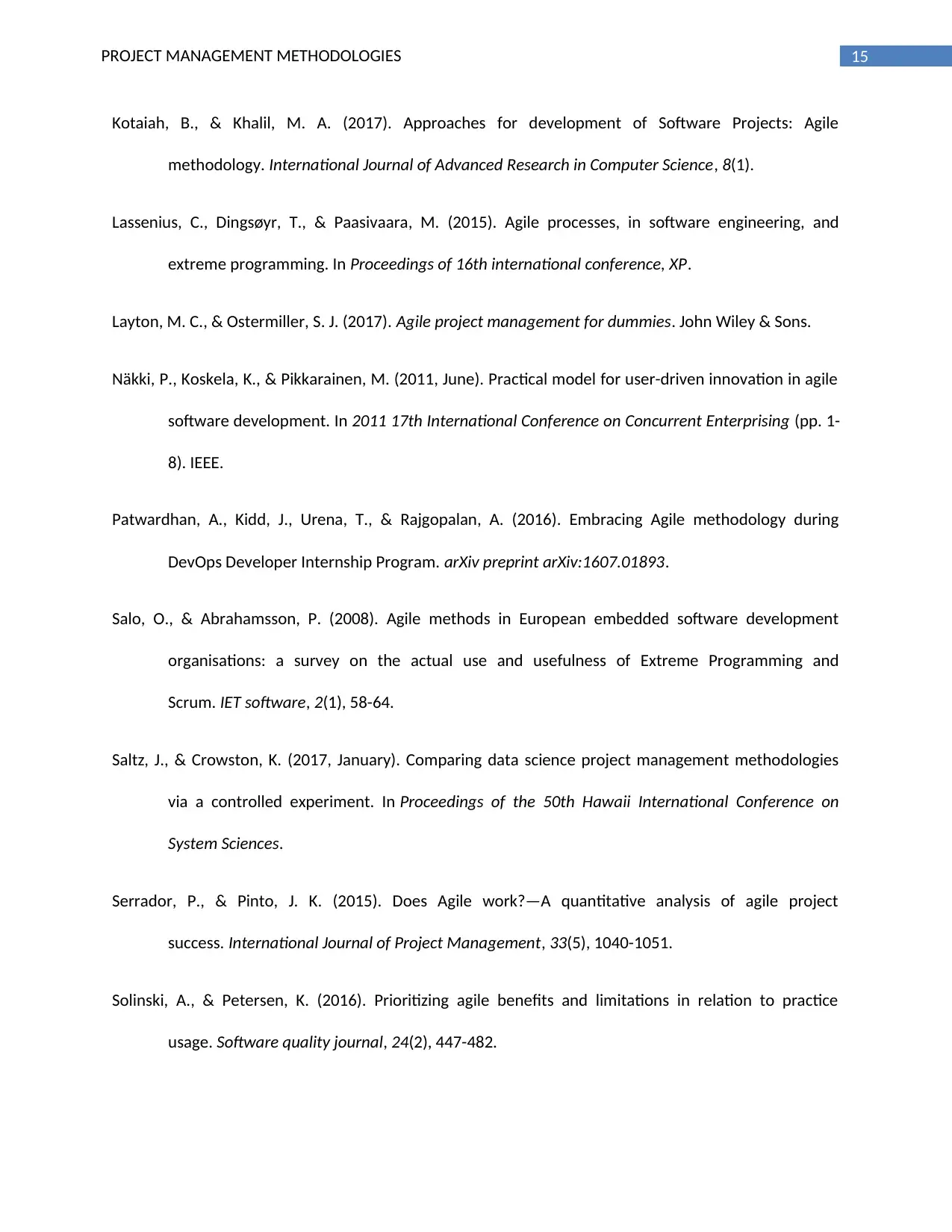
15PROJECT MANAGEMENT METHODOLOGIES
Kotaiah, B., & Khalil, M. A. (2017). Approaches for development of Software Projects: Agile
methodology. International Journal of Advanced Research in Computer Science, 8(1).
Lassenius, C., Dingsøyr, T., & Paasivaara, M. (2015). Agile processes, in software engineering, and
extreme programming. In Proceedings of 16th international conference, XP.
Layton, M. C., & Ostermiller, S. J. (2017). Agile project management for dummies. John Wiley & Sons.
Näkki, P., Koskela, K., & Pikkarainen, M. (2011, June). Practical model for user-driven innovation in agile
software development. In 2011 17th International Conference on Concurrent Enterprising (pp. 1-
8). IEEE.
Patwardhan, A., Kidd, J., Urena, T., & Rajgopalan, A. (2016). Embracing Agile methodology during
DevOps Developer Internship Program. arXiv preprint arXiv:1607.01893.
Salo, O., & Abrahamsson, P. (2008). Agile methods in European embedded software development
organisations: a survey on the actual use and usefulness of Extreme Programming and
Scrum. IET software, 2(1), 58-64.
Saltz, J., & Crowston, K. (2017, January). Comparing data science project management methodologies
via a controlled experiment. In Proceedings of the 50th Hawaii International Conference on
System Sciences.
Serrador, P., & Pinto, J. K. (2015). Does Agile work?—A quantitative analysis of agile project
success. International Journal of Project Management, 33(5), 1040-1051.
Solinski, A., & Petersen, K. (2016). Prioritizing agile benefits and limitations in relation to practice
usage. Software quality journal, 24(2), 447-482.
Kotaiah, B., & Khalil, M. A. (2017). Approaches for development of Software Projects: Agile
methodology. International Journal of Advanced Research in Computer Science, 8(1).
Lassenius, C., Dingsøyr, T., & Paasivaara, M. (2015). Agile processes, in software engineering, and
extreme programming. In Proceedings of 16th international conference, XP.
Layton, M. C., & Ostermiller, S. J. (2017). Agile project management for dummies. John Wiley & Sons.
Näkki, P., Koskela, K., & Pikkarainen, M. (2011, June). Practical model for user-driven innovation in agile
software development. In 2011 17th International Conference on Concurrent Enterprising (pp. 1-
8). IEEE.
Patwardhan, A., Kidd, J., Urena, T., & Rajgopalan, A. (2016). Embracing Agile methodology during
DevOps Developer Internship Program. arXiv preprint arXiv:1607.01893.
Salo, O., & Abrahamsson, P. (2008). Agile methods in European embedded software development
organisations: a survey on the actual use and usefulness of Extreme Programming and
Scrum. IET software, 2(1), 58-64.
Saltz, J., & Crowston, K. (2017, January). Comparing data science project management methodologies
via a controlled experiment. In Proceedings of the 50th Hawaii International Conference on
System Sciences.
Serrador, P., & Pinto, J. K. (2015). Does Agile work?—A quantitative analysis of agile project
success. International Journal of Project Management, 33(5), 1040-1051.
Solinski, A., & Petersen, K. (2016). Prioritizing agile benefits and limitations in relation to practice
usage. Software quality journal, 24(2), 447-482.
Secure Best Marks with AI Grader
Need help grading? Try our AI Grader for instant feedback on your assignments.

16PROJECT MANAGEMENT METHODOLOGIES
Sunder M, V. (2016). Lean Six Sigma project management–a stakeholder management perspective. The
TQM Journal, 28(1), 132-150.
Syed-Abdullah, S., Holcombe, M., & Gheorge, M. (2006). The impact of an agile methodology on the well
being of development teams. Empirical Software Engineering, 11(1), 143-167.
ur Rehman, F., Maqbool, B., Riaz, M. Q., Qamar, U., & Abbas, M. (2018, April). Scrum Software
Maintenance Model: Efficient Software Maintenance in Agile Methodology. In 2018 21st Saudi
Computer Society National Computer Conference (NCC) (pp. 1-5). IEEE.
Sunder M, V. (2016). Lean Six Sigma project management–a stakeholder management perspective. The
TQM Journal, 28(1), 132-150.
Syed-Abdullah, S., Holcombe, M., & Gheorge, M. (2006). The impact of an agile methodology on the well
being of development teams. Empirical Software Engineering, 11(1), 143-167.
ur Rehman, F., Maqbool, B., Riaz, M. Q., Qamar, U., & Abbas, M. (2018, April). Scrum Software
Maintenance Model: Efficient Software Maintenance in Agile Methodology. In 2018 21st Saudi
Computer Society National Computer Conference (NCC) (pp. 1-5). IEEE.
1 out of 17
Related Documents
Your All-in-One AI-Powered Toolkit for Academic Success.
+13062052269
info@desklib.com
Available 24*7 on WhatsApp / Email
![[object Object]](/_next/static/media/star-bottom.7253800d.svg)
Unlock your academic potential
© 2024 | Zucol Services PVT LTD | All rights reserved.





